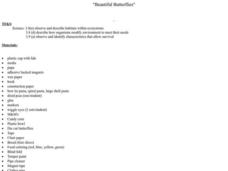Curated OER
Coral Reefs
Students examine the animals that live in a coral reef and how they adapt to their environment. In this coral activity students write a short book on how animals inhabit the coral reefs.
Curated OER
Symmetry in Butterflies
Students create a butterfly displaying a mirror image of itself to show that it is symmetrical. In this symmetry lesson plan, students go over symmetry in different shapes and identify patterns in butterflies.
Curated OER
Magic Tree House - Afternoon on the Amazon (Ch. 4)
In this comprehension worksheet, students read the book Afternoon on the Amazon chapter 4 from Magic Tree House, and answer short answer questions and define vocabulary words. Students complete 10 problems.
Curated OER
Land Use Issues
Students participate in activities in which they examine land use. They examine the types of animals in a surrounding and how they blend in with the environment. They also examine food resources.
Curated OER
Coloration
Young scholars conduct an experiment picking out colored vs. camoflauged toothpicks out of the grass. They list and describe different types of coloration and explain how coloration assists the great horned owl and the striped skunk...
Curated OER
Wildlife Habitat
Students explain what a habitat is and describe its four elements. They see how an area's habitat suitability varies with different species of wildlife. They name factors that affect habitat suitability.
Curated OER
Spiders Have Natural Enemies
Students explore the different types of enemies that spiders have.
Curated OER
Beautiful Butterflies
Third graders study the life cycle of the butterfly through this series of activities. They create projects, play games, and observe butterfly characteristic that contribute to their survival.
Curated OER
Head to Foot
Students describe the body form and major anatomical structures of squids and describe some unusual or unique features of newly-discovered deep water squid species. They infer what types of food squids use from their anatomical features.
Curated OER
What's Bright Red and Invisible?
Students study that very little sunlight penetrates the ocean below depths of 200 meters. They study that no light penetrates the ocean below depths of 1000 meters. They study that the quality of light changes as depth increase
Curated OER
Light at the Bottom of the Deep, Dark Ocean?
Students participate in an inquiry activity. They relate the structure of an appendage to its function. They describe how a deepwater organism to its environment without bright light.
Curated OER
Potato Fish Adaptations
Students examine fish adaptations. They identify types of adaptations, and create a 3-D model of an imaginary fish that demonstrates various adaptations using a potato and craft materials.
Curated OER
The Great Spider Debate
Students study about the survival and hunting strategies of several different kinds of spiders. They also be introduced to scientific classification of spiders and write a brief report about one of the spider families they observe.
Curated OER
Survival of the Fittest
Sixth graders create their own "never before seen" marine creatures and examine how not all creatures in the sea swim, not all have sharp teeth
Curated OER
Environmental Mathematics
Eighth graders determine food that they would need to survive in the wild. They graph the best foods for their environments and rate the survivability rate for each member of their group.
Curated OER
Ambush Warriors
Middle schoolers identify four different categories of reptiles and explain how snakes deliver their venom to their prey.
Curated OER
Building a Topographic Model
Students explore Mount Shasta and various locations on Mars to examine ways geographical data can be represented. They study topographic maps and translating data from 2-Dimensions to 3-Dimensions.
Curated OER
Adaptable Animals
Pupils examine the types of adaptations that animals use to survive. They research the animals and report their findings to the class.
Curated OER
Build a Bug
Students design an ideally adapted macroinvertebrate to live in a water habitat. They illustrate their animal, name it and specify the adaptations it has that enable it to survive.
Curated OER
Survival Features
Third graders identify features of producers, herbivores and carnivores. They discuss the features that aid in survival for those animals. They organize animals into categories to complete the lesson.
Curated OER
Creatures That Glow In The Night
Learners investigate the different bioluminescent organisms. They use microscopes in order to make observations and draw what is seen. Students demonstrate they have studies the differences between the process of photosynthesis and...
Curated OER
Surviving in Our Ecosystems
Third graders identify the characteristics of a frog and compare them to a human child. They draw and describe the best environment for a human to live in and the best environment for a frog to live in based on their physical...
Curated OER
Snow Lovers or Haters
Learners explain the three classifications that define how wildlife species react to winter; and name at least four examples each of chionophobes, chioneuphores, and chionophiles.
Curated OER
Hide & Seek Butterflies
Students examine a variety of butterflies and discuss how they believe they get their color variations. In groups, they brainstorm the advantages and disadvantages of their color schemes. To end the lesson, they watch butterflies in...
Other popular searches
- Animal Camouflage
- Butterflies and Camouflage
- Camouflage and Mimicry
- Camouflage and Art
- Biology Camouflage
- Camouflage by Animals
- Camouflage Mimicry
- Camouflage Lessons
- Camouflage in the Ocean
- Powerpoint Animal Camouflage
- Camouflage Moths
- Animal Camouflage Adaptation

























